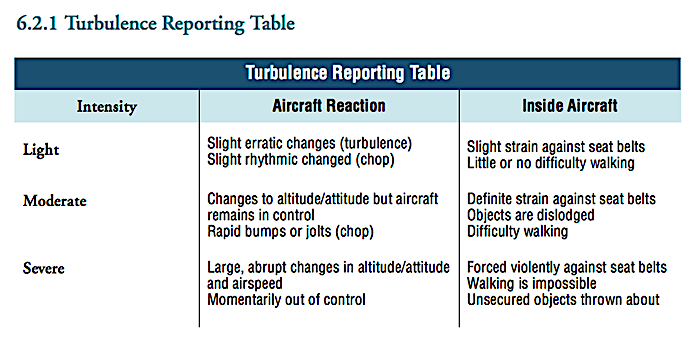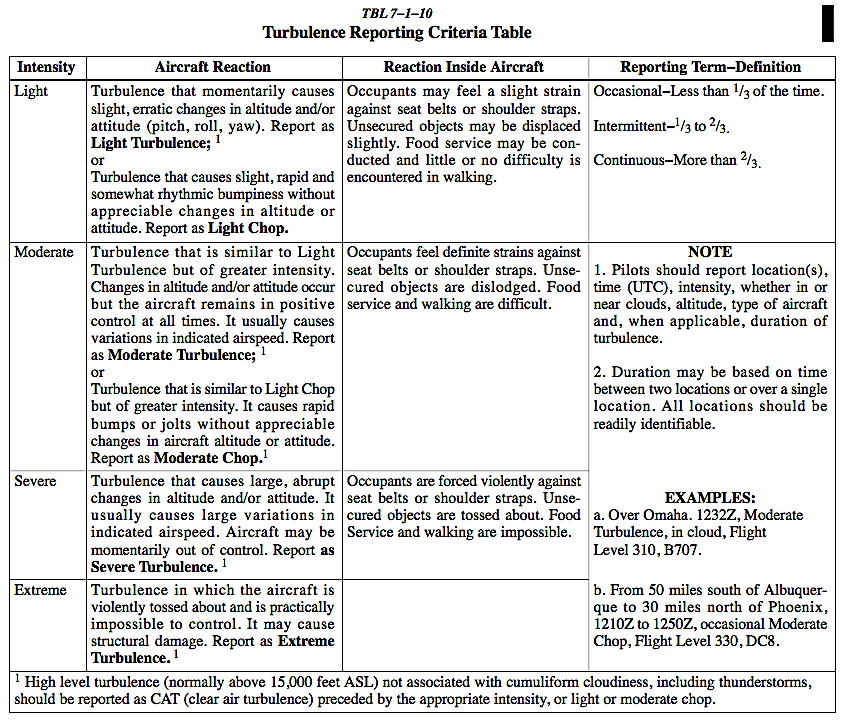Turbulence Hazards to Aviation
Learning Goal 3c. Describe how different types of turbulence form, and relate turbulence intensities to aircraft behavior
Turbulent Scales of Motion
Turbulence is the random gusty fluctuations (vertical & horizontal) of the wind. Turbulence usually consists of many different size swirls of air motion (called eddies) superimposed on each other.
The smaller eddies cause a bumpy ride, as in Fig (c) below. The medium-size eddies cause the aircraft randomly tilt up and down (pitch-angle changes), rock back and forth (bank-angle changes), and swivel left and right (yaw-angle changes), as sketched in Fig (b) below. The larger-size eddies can move the whole aircraft up and down (Fig a below), left and right, forward and back.

An excellent YouTube video in the cockpit of a Boeing 747-400, experiencing turbulence while approaching to land at Anchorage, Alaska:
https://www.youtube.com/watch?v=_21Ojt_Y01E
Turbulence Intensities
Turbulence can have different intensisites: light, moderate, severe, and extreme. Only the first 3 categores are used in Canada. These intensities are determined by the how bumpy the aircraft ride is and what is happening to objects inside the aircraft.
Here is a table from the NavCanada Aviation Weather Services Guide showing how to report turbulence intensity.
And below is a similar table from the US FAA Aeronautical
Information Manual (2014)
When turbulence is weak, it is just an inconvenience (like a slightly bumpy ride in a car), but is not a hazard to aviation. Moderate turbulence can cause sensitive passengers to become airsick (nausea, vomiting, vertigo), so be sure to have barf bags in the aircraft. Severe turbulence is exhausting for the pilot to fly in because of the hard work manipulating the controls to keep the aircraft level, on course, and on altitude. Extreme turbulence can cause things (such as the wings) on the aircraft to break — so you never should fly into a region where extreme turbulence is possible (such as a thunderstorm, or strong mountain-wave turbulence).
How Turbulence Forms
Natural turbulence can be created by 3 different processes:
- convective turbulence, or free convection, or thermal turbulence (due to buoyancy: warm air rising and cold air sinking)
- wind-shear turbulence, or forced convection, or mechanical turbulence (different wind speeds or wind directions at different altitudes)
- obstacle turbulence (caused by wind hitting an object and flowing around it). The wakes behind fixed objects such as mountains will be discussed here.
In addition, aircraft leave a trail of turbulence and vortices behind them as
they
fly. This human-caused is called wake turbulence,
and will not be discussed in this section on natural turbulence, but
you can learn a bit about it from the contrail section of Learning Goal
1b.
Types / Locations for Turbulence
We will investigate these turbulence types in detail in the next learning goals:
- mountain-wave turbulence (see Learning Goal 3d),
- clear-air turbulence (Learning Goal 3e),
- boundary-layer and obstacle-wake turbulence (Learning Goal 3f), and
- convective turbulence including thunderstorm turbulence (Learning Goals 4b-g).
Key words: turbulence, eddies, convective
turbulence, wind-shear turbulence, free convection, forced convection,
thermal turbulence, mechanical turbulence, wake turbulence
Extra info for experts; not needed for this course.
NavCanada Aviation Weather Services Guide (p22) showing how to report turbulence intensity.
A table on turbulence-reporting criteria (Table 7-1-10) from section 7-1-23 the US FAA Aeronautical Information Manual (AIM) most recent: https://www.faa.gov/air_traffic/publications/
You can find the identical info from the US FAA AC 00-45_ ( most recent version) Aviation Weather Services advisory circular, in section 3.2.1.10 Turbulence (in Table 3-8).
Image credits: The first figure is copyright by Roland Stull, and used with his permission. Government sources for the tables above are indicated in or near the table captions, and in the Extra Info box.

